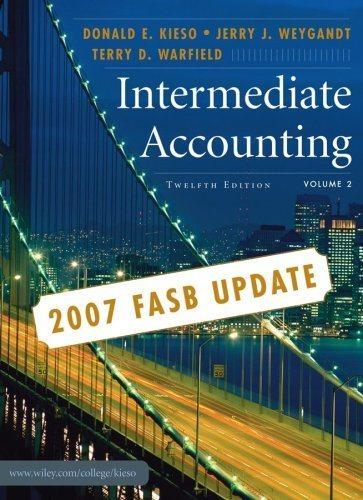(Lessee-Lessor Accounting for Residual Values) Lanier Dairy leases its milking equipment from Zeff Finance Company under the...
Question:
(Lessee-Lessor Accounting for Residual Values) Lanier Dairy leases its milking equipment from Zeff Finance Company under the following lease terms.
1. The lease term is 10 years, noncancelable, and requires equal rental payments of $25,250 due at the beginning of each year starting January 1, 2007.
2. The equipment has a fair value and cost at the inception of the lease (January 1, 2007) of $185,078, an estimated economic life of 10 years, and a residual value (which is guaranteed by Lanier Dairy)
of $20,000.
3. The lease contains no renewable options, and the equipment reverts to Zeff Finance Company upon termination of the lease.
4, Lanier Dairy’s incremental borrowing rate is 9% per year. The implicit rate is also 9%.
Lanier Dairy depreciates similar equipment that it owns on a straight-line basis.
6. Collectibility of the payments is reasonably predictable, and there are no important uncertainties surrounding the costs yet to be incurred by the lessor.
aa Instructions
(a) Evaluate the criteria for classification of the lease, and describe the nature of the lease. In general, discuss how the lessee and lessor should account for the lease transaction.
(b) Prepare the journal entries for the lessee and lessor at January 1, 2007, and December 31, 2007
(the lessee’s and lessor’s year-end). Assume no reversing entries.
(c) What would have been the amount capitalized by the lessee upon the inception of the lease if:
(1) The residual value of $20,000 had been guaranteed by a third party, not the lessee?
(2) The residual value of $20,000 had not been guaranteed at all?
(d) On the lessor’s books, what would be the amount recorded as the Net Investment (Lease Receivable) at the inception of the lease, assuming:
(1) The residual value of $20,000 had been guaranteed by a third party?
(2) The residual value of $20,000 had not been guaranteed at all?
(e) Suppose the useful life of the milking equipment is 20 years. How large would the residual value have to be at the end of 10 years in order for the lessee to qualify for the operating method? (Assume that the residual value would be guaranteed by a third party.) (Hint: The lessee’s annual payments will be appropriately reduced as the residual value increases.)
Step by Step Answer:

Intermediate Accounting 2007 FASB Update Volume 2
ISBN: 9780470128763
12th Edition
Authors: Donald E. Kieso, Jerry J. Weygandt, Terry D. Warfield





